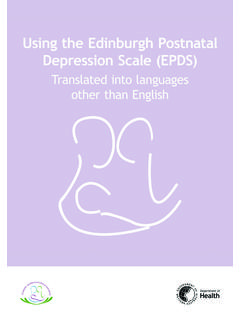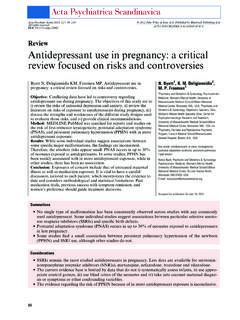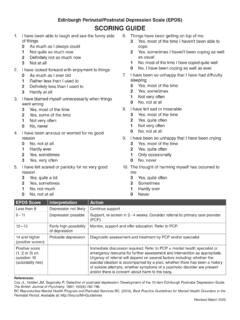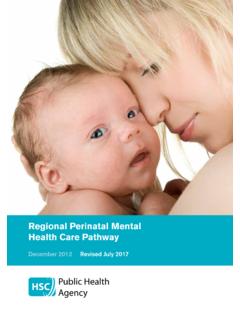Transcription of Escala Edinburgh para la Depresión Postnatal …
1 Podido re r y ver el lado bueno de las cosas:Tanto como siempre he podido hacerlo____ 0No tanto ahora____ 1 Sin duda, mucho menos ahora____ 2No, en absoluto____ mirado al futuro con placer para hacer cosas:Tanto como siempre____ 0 Algo menos de lo que sol a hacerlo____ 1 Definitivamente menos de lo que sol a hacerlo____ 2Pr cticamente nunca____ he culpado sin necesidad cuando las cosasmarchaban mal:S , casi siempre____ 3S , algunas veces____ 2No muy a menudo____ 1No, nunca____ estado ansiosa y preocupada sin motivo alguno:No, en absoluto____ 0 Casi nada____ 1S , a veces____ 2S , muy a menudo____ sentido miedo o p nico sin motivo alguno:S , bastante____ 3S , a veces____ 2No, no mucho____ 1No, en absoluto____ 0 Escala Edinburgh para la Depresi n Postnatal (Spanish Version) cosas me oprimen o agobian:S , la mayor parte del tiempo no he podidosobrellevarlas____ 3S , a veces no he podido sobrellevarlas dela manera____ 2No, la mayor a de las veces he podidosobrellevarlas bastante bien____ 1No, he podido sobrellevarlas tan bien comolo hecho siempre____ he sentido tan infeliz, que he tenido dificultadpara dormir:S , casi siempre____ 3S , a veces____ 2No muy a menudo____ 1No, en absoluto____ he sentido triste y desgraciada:S , casi siempre____ 3S , bastante a menudo____ 2No muy a menudo____ 1No, en absoluto____ he sentido tan infeliz que he estado llorando:S , casi siempre____ 3S , bastante a menudo____ 2 Ocasionalmente____ 1No, nunca____ 010.
2 He pensado en hacerme da o:S , bastante a menudo____ 3A veces____ 2 Casi nunca____ 1No, nunca____ 0 ESCRIBA EL TOTAL DE SU PUNTAJE AQU : Edinburgh Postnatal Depression Scale (EPDS). Texto adaptado del British Journal of Psychiatry,Junio, 1987, vol. 150 por Cox, Holden, R. Segovsky. Nombre de participante:N mero de identificaci n de participante:Fecha: Como usted est embarazada o hace poco que tuvo un beb , nos gustar a saber como se siente actualmente. Por favorMARQUE ( ) la respuesta que m s se acerca a como se ha sentido durante LOS LTIMOS 7 D AS y no s lo como se hasentido continuaci n se muestra un ejemplo completado:Me he sentido feliz:S , todo el tiempo____ 0S , la mayor parte del tiempo____ 1No, no muy a menudo____ 2No, en absoluto____ 3 Esto significa: Me he sentido feliz la mayor parte del tiempo durante la ltima semana. Por favor complete las otras preguntas de la misma THE EPDSR esponse categories are scored 0, 1, 2 and 3according to increased severity of the symptom.
3 Items 3,5-10 are reverse scored ( , 3, 2, 1, and 0). The totalscore is calculated by adding together the scores for eachof the ten items. Users may reproduce the scale withoutfurther permission providing they respect copyright (whichremains with the British Journal of Psychiatry) quoting thenames of the authors, the title and the source of thepaper in all reproduced Edinburgh Postnatal Depression Scale (EPDS) wasdeveloped to assist primary care health professionals indetecting mothers suffering from postpartum depression(PPD); a distressing disorder more prolonged than the blues (which occur in the first week after delivery), butless severe than puerperal studies have shown that PPD affects at least10 percent of women and that many depressed mothersremain untreated. These mothers may cope with theirbaby and with household tasks, but their enjoyment of lifeis seriously affected and it is possible that there are longterm effects on the EPDS was developed at health centers inLivingston and Edinburgh .
4 It consists of 10 shortstatements. The mother underlines which of the fourpossible responses is closest to how she has beenfeeling during the past week. Most mothers complete thescale without difficulty in less than five validation study showed that mothers who scoredabove a threshold 12/13 were likely to be suffering from adepressive illness of varying severity. Nevertheless, theEPDS score should not override clinical judgement. Acareful clinical assessment should be carried out toconfirm the diagnosis. The scale indicates how the motherfelt during the previous week, and in doubtful cases it maybe usefully repeated after two weeks. The scale will notdetect mothers with anxiety neuroses, phobias orpersonality FOR USERS1. The mother is asked to underline the response thatcomes closest to how she has felt during the previousseven All 10 items must be Care should be taken to avoid the possibility of themother discussing her answers with The mother should complete the scale herself, unlessshe has limited English or has difficulty with The EPDS may be used at six to eight weeks to screenpostnatal women or during pregnancy.
5 The child healthclinic, postpartum check-up or a home visit may providesuitable opportunities for its Postnatal Depression Scale (EPDS) Scoring & Other InformationCox, J. L., Holden, J. M., & Sagovsky, R. (1987). Detection of Postnatal depression: Development of the 10-item Edinburgh Postnatal Depression Journal of Psychiatry,150, 782-786. The Spanish version was developed at the University of Iowa based on earlier Spanish versions of theinstrument. For further information, please contact Michael W. O Hara, Department of Psychology, University of Iowa, Iowa City, IA 52245.







